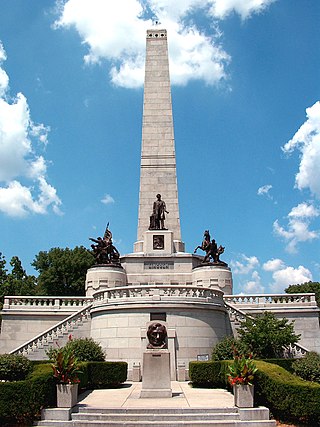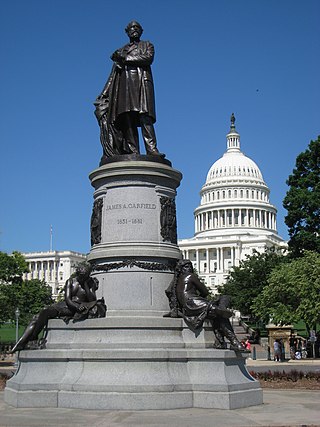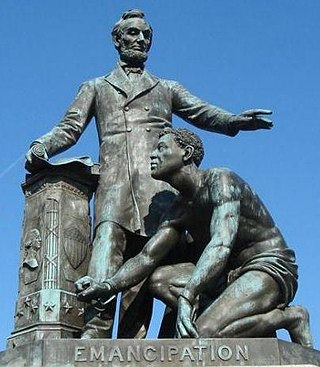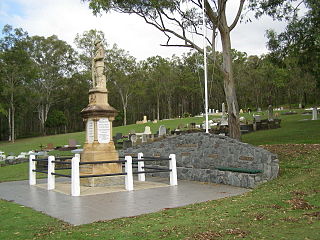
The Tenantry Column is a monument to the south of Alnwick town centre, in Northumberland, England. It was erected in 1816 by the tenants of Hugh Percy, 2nd Duke of Northumberland in thanks for his reduction of their rents during the post-Napoleonic depression. It is a Doric column standing 83 feet (25 m) tall and surmounted by a lion en passant, the symbol of the Percy family. Four more lions stand on a platform at the base of the column. A muster roll of the Percy Tenantry Volunteers was sealed into the foundation. The structure was granted protection as a listed building in 1952 and since 1977 has been listed in the highest category, grade I.

The Lincoln Tomb is the final resting place of Abraham Lincoln, the 16th president of the United States; his wife Mary Todd Lincoln; and three of their four sons: Edward, William, and Thomas. It is located in Oak Ridge Cemetery in Springfield, Illinois.

The James A. Garfield Monument stands on the grounds of the United States Capitol in Garfield Circle, a traffic circle at First Street and Maryland Avenue SW in Washington, D.C. It is a memorial to U.S. President James A. Garfield, who was elected in 1880 and assassinated in 1881 after serving only four months of his term. The perpetrator was an attorney and disgruntled office-seeker named Charles J. Guiteau. Garfield lived for several weeks after the shooting, but eventually succumbed to his injuries. The monument is part of a three-part sculptural group near the Capitol Reflecting Pool, including the Peace Monument and the Ulysses S. Grant Memorial in Union Square. The monument is also a contributing property to the National Mall and L'Enfant Plan, both of which are listed on the National Register of Historic Places and the District of Columbia Inventory of Historic Sites. The bronze statue rests on a granite pedestal that features three sculptures, each one representing a time period in Garfield's life.

Winchester National Cemetery is a United States National Cemetery located in the city of Winchester in Frederick County, Virginia. Administered by the United States Department of Veterans Affairs, it encompasses 4.9 acres (2.0 ha), and as of the end of 2005, it had 5,561 interments. It is closed to new interments.

The Civil War Memorial, in the DeKalb County county seat of Sycamore, Illinois, United States, is located in front of the DeKalb County Courthouse on a public square. The memorial was erected in 1896 and dedicated in 1897. The structure is a memorial to the thousands of DeKalb County residents who served in the American Civil War. It incorporates an obelisk which rises to 50 feet in height. The base is adorned with copper sculpture, completed by an unknown sculptor. On the east facade of the memorial the word "Antietam", denoting the Battle of Antietam, is misspelled. This work of public art underwent its first restoration work in 2005-2006.

The Confederate Monument in Georgetown is within the Georgetown Cemetery of Georgetown, Kentucky. It is an unpolished granite obelisk that is twenty feet tall, surrounded by the graves of eighteen former Confederate soldiers. The various reliefs upon the obelisk include crossed cannons, crossed muskets, a drum, an azid, and flags. It was placed on the National Register of Historic Places on July 17, 1997, as part of the Civil War Monuments of Kentucky Multiple Property Submission.

The Emancipation Memorial, also known as the Freedman's Memorial or the Emancipation Group is a monument in Lincoln Park in the Capitol Hill neighborhood of Washington, D.C. It was sometimes referred to as the "Lincoln Memorial" before the more prominent national memorial was dedicated in 1922.

The Confederate Monument in Danville, originally located between Centre College and the First Presbyterian Church at the corner of Main and College Streets in Danville, Kentucky, was a monument dedicated to the Confederate States of America that is on the National Register of Historic Places. The monument was dedicated in 1910 by the surviving veterans of the Confederacy of Boyle County, Kentucky and the Kate Morrison Breckinridge Chapter of the United Daughters of the Confederacy (UDC). In 2021, it was relocated to a museum in Meade County, Kentucky.

The Trenton Battle Monument is a massive column-type structure in the Battle Monument section of Trenton, Mercer County, New Jersey, United States. It commemorates the December 26, 1776, Battle of Trenton, a pivotal victory for the Continental forces and commander George Washington during the American Revolutionary War.

The Machine Gun Corps Memorial, also known as The Boy David, is a memorial to the casualties of the Machine Gun Corps in the First World War. It is located on the north side of the traffic island at Hyde Park Corner in London, near the Wellington Arch, an Equestrian statue of the Duke of Wellington, the Royal Artillery Memorial, the New Zealand War Memorial, and the Australian War Memorial.

Lewis County Soldiers' and Sailors' Monument is a historic American Civil War monument located at Lowville in Lewis County, New York. It was built in 1883 by Monumental Bronze Company of Bridgeport, Connecticut, and is constructed of sand-cast zinc. It is 20 feet high and 78 inches square and consists of five parts: a three stepped base, a plinth, a tapered column, a capital, and on the top a soldier.

College Square Historic District is a nationally recognized historic district located on a bluff north of downtown Davenport, Iowa, United States. It was listed on the National Register of Historic Places in 1983. The district derives it name from two different colleges that were located here in the 19th century.

The Dillon Memorial is a historic structure located in LeClaire Park, near downtown Davenport, Iowa, United States. It was listed on the National Register of Historic Places (NRHP) in 1983 and on the Davenport Register of Historic Properties in 1993. It is commonly referred to as the Dillon Fountain.

The Clayton County Courthouse, located in Elkader, Iowa, United States, was built in 1878. It was listed on the National Register of Historic Places in 1976 as a part of the County Courthouses in Iowa Thematic Resource.

The Rough Riders Memorial is a memorial in Arlington National Cemetery in Arlington County, Virginia, in the United States that commemorates those members of the "Rough Riders" who died in the Spanish–American War in 1898. The grey granite shaft was erected by surviving members of the Rough Riders and their friends and supporters. Although Arlington National Cemetery, a number of secondary sources, and even the bronze plaque on the memorial say the monument was dedicated in 1906 and one source says 1905, contemporary newspaper accounts show the memorial was dedicated on April 12, 1907.

Pimpama & Ormeau War Memorial is a heritage-listed memorial at Pacific Highway, Pimpama, Queensland, Australia. It was built in 1919. It was added to the Queensland Heritage Register on 21 October 1992.

The Royal Artillery Boer War Memorial is located on the south side of The Mall in Central London, close to the junction with Horse Guards Road at the northeast corner of St James's Park. Unveiled in 1910, it marks the deaths of the 1,083 soldiers of the Royal Artillery who died in the Second Boer War from 1899 to 1902 It has been a listed building since 1970.

The Soldiers and Sailors Monument in Watertown, New York was erected in 1891 to commemorate local citizens who fought in the Civil War. The monument rests upon the former village green, which has been located there since 1805.

The Soldiers' Monument is a cenotaph at the center of the Santa Fe Plaza, a monument collectively memorializing deaths in several specified battles. It is obscured from public view and access by concreteboard walls used as a preservation measure. Erected during the late 1860s in the aftermath of the American Civil War, it consisted of a 33 feet (10 m) stone obelisk atop a plinth; only the plinth stands currently, and exhibits some damage. During the late nineteenth century, the monument was used as a place for Union veterans to gather at annual Memorial Day events to decorate the cenotaph and hear brief presentations.






















